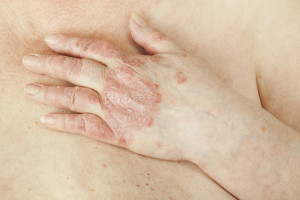Written by Greg Arnold, DC, CSCS. Fifty Japanese study participants significantly improved their symptoms of eczema when they supplemented with the probiotic Saccharomyces cerevisisiae L92 for just 24 weeks.
 Atopic dermatitis, more commonly known as eczema, is a chronic skin infection that starts in the early years of life. It is characterized by varying degrees of redness and itching 1 on the face and in the skin folds of the arms and legs. Although its cause is not known, risk factors include family history of asthma and hay fever 1,2. It is estimated that eczema affects 31.6 million Americans, costs our healthcare system as much as $4 billion per year 3,4 and can have a significant detrimental effect on a person’s quality of life 5.
Atopic dermatitis, more commonly known as eczema, is a chronic skin infection that starts in the early years of life. It is characterized by varying degrees of redness and itching 1 on the face and in the skin folds of the arms and legs. Although its cause is not known, risk factors include family history of asthma and hay fever 1,2. It is estimated that eczema affects 31.6 million Americans, costs our healthcare system as much as $4 billion per year 3,4 and can have a significant detrimental effect on a person’s quality of life 5.
A 2016 study in Japan 6 involved 50 Japanese subjects (22 men, 28 women) aged 16 to 49 who were receiving “standard prescription medication” for atopic dermatitis (as defined by the Japanese Medical Association). They received either 20.7 milligrams of a certain strain of Lactobacillus (L-92 strain = 24 subjects) or placebo (26 subjects) for 24 weeks. Before and after the study, physicians assessed atopic dermatitis symptom severity using a validated questionnaire called SORAD (Scoring Atopic Dermatitis) 7 and another questionnaire called EASI (Eczema area severity index) 8. Blood samples were taken to measure for inflammatory proteins called cytokines.
Those in the L-92 treatment group had significant improvements in their eczema symptoms compared to placebo:
| L-92 | Placebo | p-value | |
|---|---|---|---|
| SCORAD | -6.30 ( -19.20 to 4.3) | -1.10 (16.60 to 5.60) | 0.00003 |
| EASI | -10.65 (-23.50 to 6.90) | -0.15 (-12.30 to 12.10) | 0.01 |
| IGA | -1 (-2 to 0) | 0 (-2 to1) | 0.0004 |
With respect to serum cytokines, at week 24 there was a significant increase in IL-12 (p=0.049) compared to before treatment level and at week 16 there was a significant increase in serum TGF-β compared to placebo (p=0.03).
Although this study was done in a homogenous group (Japanese subjects), the researchers concluded that “Atopic dermatitis symptoms could be improved when long-term intake of the L-92 strain is combined with prescribed medications.”
Source: Yamamoto K, Yokoyama K, Matsukawa T, et al. Efficacy of prolonged ingestion of Lactobacillus acidophilus L-92 in adult patients with atopic dermatitis. Journal of dairy science. 2016; 99(7):5039-5046; http://dx.doi.org/10.3168/jds.2015-10605
© American Dairy Science Association®, 2016.
Posted February 21, 2017.
Greg Arnold is a Chiropractic Physician practicing in Hauppauge, NY. You can contact Dr. Arnold directly by emailing him at PitchingDoc@msn.com or visiting his web site at www.PitchingDoc.com.
References:
- Atopic Dermatitis: Diagnosis recommendations. 2017; https://www.aad.org/practice-tools/quality-care/clinical-guidelines/atopic-dermatitis/diagnosis-and-assessment. Accessed January 30, 2017, 2017.
- Larsen FS, Hanifin JM. Epidemiology of atopic dermatitis. Immunology and Allergy Clinics of North America. 2002;22(1):1-24.
- Carroll CL, Balkrishnan R, Feldman SR, Fleischer AB, Manuel JC. The burden of atopic dermatitis: impact on the patient, family, and society. Pediatric dermatology. 2005;22(3):192-199.
- Ellis CN, Drake LA, Prendergast MM, et al. Cost of atopic dermatitis and eczema in the United States. Journal of the American Academy of Dermatology. 2002;46(3):361-370.
- Dermatology AAo. Eczema Can Have Many Effects on Patients’ Health. 2016; Overview of effects of eczema on patient’s health. Available at: www.sciencedaily.com/releases/2016/07/160728102214.htm. Accessed January 30, 2017, 2017.
- Yamamoto K, Yokoyama K, Matsukawa T, et al. Efficacy of prolonged ingestion of Lactobacillus acidophilus L-92 in adult patients with atopic dermatitis. Journal of dairy science. 2016;99(7):5039-5046.
- Dermatitis ETFoA. Severity scoring of atopic dermatitis: the SCORAD index. Dermatology. 1993;186:23-31.
- Hanifin J, Thurston M, Omoto M, et al. The eczema area and severity index (EASI): assessment of reliability in atopic dermatitis. Experimental dermatology. 2001;10(1):11-18.
